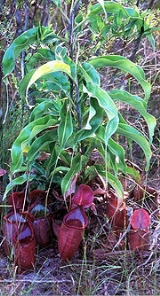
Nepenthes rowanae
Encyclopedia
Nepenthes rowanae is a species of pitcher plant
endemic
to Cape York
, Australia
. It is closely related to N. mirabilis
and was once considered an extreme form of this species.
 Between 1881 and 1905, Frederick Manson Bailey
Between 1881 and 1905, Frederick Manson Bailey
described 11 species of Nepenthes
from northern Australia, all of which were placed in synonymy with N. mirabilis by B. H. Danser
in 1928. The only taxon
which Danser considered to possess morphological characters atypical of N. mirabilis was N. rowanae. He wrote:
However, field observations carried out between 2001 and 2003 "showed that N. rowanae possesses several stable, significant morphological and ecological characteristics that are not exhibited by N. mirabilis", and the taxon was subsequently elevated to a species in 2005.
Pitcher plant
Pitcher plants are carnivorous plants whose prey-trapping mechanism features a deep cavity filled with liquid known as a pitfall trap. It has been widely assumed that the various sorts of pitfall trap evolved from rolled leaves, with selection pressure favouring more deeply cupped leaves over...
endemic
Endemic (ecology)
Endemism is the ecological state of being unique to a defined geographic location, such as an island, nation or other defined zone, or habitat type; organisms that are indigenous to a place are not endemic to it if they are also found elsewhere. For example, all species of lemur are endemic to the...
to Cape York
Cape York Peninsula
Cape York Peninsula is a large remote peninsula located in Far North Queensland at the tip of the state of Queensland, Australia, the largest unspoilt wilderness in northern Australia and one of the last remaining wilderness areas on Earth...
, Australia
Australia
Australia , officially the Commonwealth of Australia, is a country in the Southern Hemisphere comprising the mainland of the Australian continent, the island of Tasmania, and numerous smaller islands in the Indian and Pacific Oceans. It is the world's sixth-largest country by total area...
. It is closely related to N. mirabilis
Nepenthes mirabilis
Nepenthes mirabilis , or the Common Swamp Pitcher-Plant, is a tropical carnivorous plant species of the pitfall trap variety. It has by far the widest distribution of any Nepenthes species and is known from the following countries and regions: Borneo, Sumatra, Thailand, Peninsular Malaysia,...
and was once considered an extreme form of this species.
Taxonomy

Frederick Manson Bailey
Frederick Manson Bailey CMG was a botanist active in Australia, who made valuable contributions to the characterisation of the flora of Queensland.-Early life:...
described 11 species of Nepenthes
Nepenthes
The Nepenthes , popularly known as tropical pitcher plants or monkey cups, are a genus of carnivorous plants in the monotypic family Nepenthaceae. The genus comprises roughly 130 species, numerous natural and many cultivated hybrids...
from northern Australia, all of which were placed in synonymy with N. mirabilis by B. H. Danser
B. H. Danser
Benedictus Hubertus Danser , often abbreviated B. H. Danser, was a Dutch taxonomist and botanist...
in 1928. The only taxon
Taxon
|thumb|270px|[[African elephants]] form a widely-accepted taxon, the [[genus]] LoxodontaA taxon is a group of organisms, which a taxonomist adjudges to be a unit. Usually a taxon is given a name and a rank, although neither is a requirement...
which Danser considered to possess morphological characters atypical of N. mirabilis was N. rowanae. He wrote:
Of all these I have seen the type or at least authentic specimens, but they are nearly all mere growth forms of N. mirabilis. Only N. rowanae shows a character not yet met with in N. mirabilis, viz. campanulate-infundibuliform upper pitchers. A similar aberration, however, is often met with in several allied species and is certainly insufficient for specific distinction.
However, field observations carried out between 2001 and 2003 "showed that N. rowanae possesses several stable, significant morphological and ecological characteristics that are not exhibited by N. mirabilis", and the taxon was subsequently elevated to a species in 2005.
| Character | N. mirabilis | N. rowanae |
|---|---|---|
| Morphology of leaf blade | Acute to rounded | Contracted towards the apex, then continuing along the tendril as a narrow, acute, extension |
| Insertion of tendril to leaf blade | Simple | Peltate |
| Pitcher wings | Simple, bearing multicellular fringe elements | Often flattened at front, forming a T-shape in XS, multicellular fringe elements often present |
| Leaf blade texture | Usually chartaceous | Strongly coriaceous |
| Leaf blade attachment to stem | Simple, or rarely decurrent for ⅓ the length of the internode | Decurrent for at least ½ the length of the internode, usually more |
| Gland density in lower portion of pitcher | 1600-2500 / cm² | Approximately 3600 / cm² |
| Position of pitcher hip in upper pitchers | Mid-way, to lower half | Upper quarter |
| Position of pitcher hip in lower pitchers | Lower third to quarter | Immediately beneath peristome |
Spelling
According to the ICBN, the correct spelling of this taxon's name is Nepenthes rowaniae, as the epithet is based on the personal name Rowan. There is only one correct way to form this epithet (in the genitive: Rec 60C.1.b.) and the resulting correct spelling is mandatory; any usage of the spelling rowanae is to be corrected to rowaniae (Art 60.11). However, the literature tends to use Nepenthes rowanae, instead.Natural hybrids
- N. mirabilisNepenthes mirabilisNepenthes mirabilis , or the Common Swamp Pitcher-Plant, is a tropical carnivorous plant species of the pitfall trap variety. It has by far the widest distribution of any Nepenthes species and is known from the following countries and regions: Borneo, Sumatra, Thailand, Peninsular Malaysia,...
× N. rowanae - N. rowanae × N. tenaxNepenthes tenaxNepenthes tenax is a lowland species of tropical pitcher plant native to northern Queensland, Australia. It is the third Nepenthes species recorded from the continent and its second endemic species...

